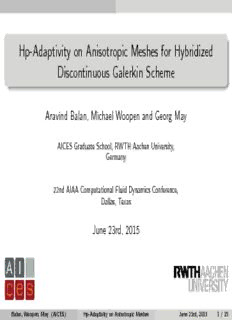
Hp-Adaptivity on Anisotropic Meshes for Hybridized Discontinuous Galerkin Scheme PDF
Preview Hp-Adaptivity on Anisotropic Meshes for Hybridized Discontinuous Galerkin Scheme
Hp-Adaptivity on Anisotropic Meshes for Hybridized Discontinuous Galerkin Scheme Aravind Balan, Michael Woopen and Georg May AICESGraduateSchool,RWTHAachenUniversity, Germany 22ndAIAAComputationalFluidDynamicsConference, Dallas,Texas June 23rd, 2015 Balan,Woopen,May (AICES) Hp-AdaptivityonAnisotropicMeshes June23rd,2015 1/15 Introduction Background and Motivation Theme of Present work: Adjoint-based anisotropic (h and hp) adaptation Context: Discontinuous Galerkin method for convection dominated flows Balan,Woopen,May (AICES) Hp-AdaptivityonAnisotropicMeshes June23rd,2015 2/15 Introduction Scope of Present Work Anisotropic adaptation based on a continuous mesh model for triangular grids Use two error estimators: Density of continuous mesh is determined by adjoint-based estimate For triangle of given area, anisotropy follows from analytic minimization of the interpolation error in the Lq-norm The latter is based on recently proposed error model and estimates1 For hp adaptation, choose the configuration - polynomial degree and the anisotropy - with smallest error estimate. 1V.Dolejsi.,AppliedNumericalMathematics. 82,2014. Balan,Woopen,May (AICES) Hp-AdaptivityonAnisotropicMeshes June23rd,2015 3/15 ProposedAdaptationMethod Outline 1 Proposed Adaptation Method 2 Numerical Results Balan,Woopen,May (AICES) Hp-AdaptivityonAnisotropicMeshes June23rd,2015 4/15 ProposedAdaptationMethod Mesh-Metric Duality The discrete setting: Metric tensors encode information about mesh elements e1 e2 h1 h 2θ The triangular element is equilateral w.r.t the norm induced by the metric. ||e ||2 =eTMe =C, k =1,2,3, k M k k The element is unit with respect to M Continuous Mesh: Reconstruct continuous metric Unit Mesh generated using length constraint in Riemannian geometry. Balan,Woopen,May (AICES) Hp-AdaptivityonAnisotropicMeshes June23rd,2015 5/15 ProposedAdaptationMethod Defining Size and Anisotropy Eigenvalue decomposition of the metric gives the size and shape of the triangle. (cid:18) (cid:19)T (cid:18) (cid:19)(cid:18) (cid:19) cosθ −sinθ λ 0 cosθ −sinθ M= 1 . sinθ cosθ 0 λ sinθ cosθ 2 1 1 λ = λ = , 1 h2 2 h2 1 2 The area of the triangle is given for C =3, √ 3 3 I = h h 4 1 2 We define the aspect ratio of the mesh element as β =h /h , 2 1 The triangle is described by {I,β,θ} Balan,Woopen,May (AICES) Hp-AdaptivityonAnisotropicMeshes June23rd,2015 6/15 ProposedAdaptationMethod Algorithm for h-Adaptation 1 Find the implied metric of the current mesh. 2 Determine new area, I of mesh elements using adjoint-based error estimate. If the elemental error > the cut off error, then refine I =I /r c f If the elemental error < the cut off error, then coarsen I =I ×c c f 3 Determine anisotropy {β,θ} by minimization of error model in the Lq norm. 4 {I,β,θ} is used to evaluate the desired metric on the current mesh and is fed to a metric-conforming mesh generator. 5 Do computation on new mesh 6 Done? Otherwise go to step 1 Balan,Woopen,May (AICES) Hp-AdaptivityonAnisotropicMeshes June23rd,2015 7/15 The error model in radial coordinates (x,y)=(|x|cosφ,|x|sinφ) 1 E (x)= u(p+1,φ)|x−¯x|p+1 (1) ¯x,p (p+1)! where the directional derivative of order k is given by u(k,φ) =(cid:88)k (cid:18)k(cid:19) ∂ku (cosφ)l(sinφ)k−l l ∂xl∂yk−l l=0 Error model for interpolation of u(x) is that of Taylor series π u(x) ¯x,p u(x)−π u(x)≈E (x) ¯x,p ¯x,p ProposedAdaptationMethod Error Model and Error bound Define the error function E, of degree p, as 1 (cid:88)p+1(cid:18)p+1(cid:19) ∂p+1u(¯x) E (x)= (x −x¯)l(y −y¯)p+1−l ¯x,p (p+1)! l ∂xl∂yp+1−l l=0 Balan,Woopen,May (AICES) Hp-AdaptivityonAnisotropicMeshes June23rd,2015 8/15 ProposedAdaptationMethod Error Model and Error bound Define the error function E, of degree p, as 1 (cid:88)p+1(cid:18)p+1(cid:19) ∂p+1u(¯x) E (x)= (x −x¯)l(y −y¯)p+1−l ¯x,p (p+1)! l ∂xl∂yp+1−l l=0 The error model in radial coordinates (x,y)=(|x|cosφ,|x|sinφ) 1 E (x)= u(p+1,φ)|x−¯x|p+1 (1) ¯x,p (p+1)! where the directional derivative of order k is given by u(k,φ) =(cid:88)k (cid:18)k(cid:19) ∂ku (cosφ)l(sinφ)k−l l ∂xl∂yk−l l=0 Error model for interpolation of u(x) is that of Taylor series π u(x) ¯x,p u(x)−π u(x)≈E (x) ¯x,p ¯x,p Balan,Woopen,May (AICES) Hp-AdaptivityonAnisotropicMeshes June23rd,2015 8/15 and 1 u(p+1,φp) A(cid:101)p = (p+1)!|u(p+1,φp)| ρ(cid:101)p = u(p+1,φp−π2) φ =argmax |u(p+1,φ)| (2) p φ Note: {Ap,ρp} modified from {A(cid:101)p,ρ(cid:101)p} , such that bound is safe (and sharp) ProposedAdaptationMethod Interpolation error function and bound A bound for the interpolation error function E (x) can be written, in terms of 3 ¯x,p parameters {A ,ρ ,φ } as p p p (cid:16) (cid:17)p+1 |E (x)|≤ A (x−¯x)T Q D QT (x−¯x) 2 ∀x∈Ω ¯x,p p φp ρp φp where, (cid:20) cosφ −sinφ (cid:21) (cid:34) 1 0 (cid:35) Qφp = sinφpp cosφpp , Dρp = 0 ρp−p+21 Balan,Woopen,May (AICES) Hp-AdaptivityonAnisotropicMeshes June23rd,2015 9/15
Description: